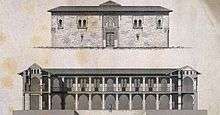Bimaristan

Bimaristan is a Persian word (بیمارستان bīmārestān) meaning "hospital", with Bimar- from Middle Persian (Pahlavi) of vīmār or vemār, meaning "sick" plus -stan as location and place suffix. In the medieval Islamic world, the word "Bimaristan" was used to indicate a hospital where the ill were welcomed and cared for by qualified staff.
Overview
Many hospitals were developed during the early Islamic era. They were called Bimaristan, which is a Persian word meaning "house [or place] of the sick."[1] The idea of a hospital being a place for the care of sick people was taken from the early Caliphs.[2] The bimaristan is seen as early as the time of the Prophet Muhammad, and the Prophet's mosque in the city of Madinah held the first Muslim hospital service in its courtyard.[3] During the Ghazwah Khandaq (the Battle of the Trench), Muhammad came across wounded soldiers and he ordered a tent be assembled to provide medical care.[3] Over time, Caliphs and rulers expanded traveling bimaristans to include doctors and pharmacists.
Umayyad Caliph Al-Walid ibn Abd al-Malik is often credited with building the first bimaristan in Damascus in 707 AD.[4] The bimaristan had a staff of salaried physicians and a well equipped dispensary.[3] It treated the blind, lepers and other disabled people, and also separated those patients with leprosy from the rest of the ill.[3] Some consider this bimaristan no more than a lepersoria because it only segregated patients with leprosy.[4] The first true Islamic hospital was built during the reign of Caliph Harun al-Rashid.[2] The Caliph invited the son of chief physician, Jabril ibn Bukhtishu to head the new Baghdad bimaristan. It quickly achieved fame and led to the development of other hospitals in Baghdad.[2]
Features of bimaristans
As hospitals developed during the Islamic civilization, specific characteristics were attained. Bimaristans were secular. They served all people regardless of their race, religion, citizenship, or gender.[2] The Waqf documents stated nobody was ever to be turned away.[3] The ultimate goal of all physicians and hospital staff was to work together to help the well-being of their patients.[3] There was no time limit a patient could spend as an inpatient;[4] the Waqf documents stated the hospital was required to keep all patients until they were fully recovered.[2] Men and women were admitted to separate but equally equipped wards.[2][3] The separate wards were further divided into mental disease, contagious disease, non-contagious disease, surgery, medicine, and eye disease.[3][4] Patients were attended to by same sex nurses and staff.[4] Each hospital contained a lecture hall, kitchen, pharmacy, library, mosque and occasionally a chapel for Christian patients.[4][5] Recreational materials and musicians were often employed to comfort and cheer patients up.[4]
The hospital was not just a place to treat patients, it also served as a medical school to educate and train students.[3] Basic science preparation was learned through private tutors, self-study and lectures. Islamic hospitals were the first to keep written records of patients and their medical treatment.[3] Students were responsible in keeping these patient records, which were later edited by doctors and referenced in future treatments.[4]
During this era, physician licensure became mandatory in the Abbasid Caliphate.[4] In 931 AD, Caliph Al-Muqtadir learned of the death of one of his subjects as a result of a physician's error.[5] He immediately ordered his muhtasib Sinan ibn Thabit to examine and prevent doctors from practicing until they passed an examination.[4][5] From this time on, licensing exams were required and only qualified physicians were allowed to practice medicine.[4][5]
See also
References
- ↑ Horden, Peregrine (Winter 2005). "The Earliest Hospitals in Byzantium, Western Europe, and Islam". Journal of Interdisciplinary History. 35 (3): 361–389. doi:10.1162/0022195052564243.
- 1 2 3 4 5 6 Nagamia, Hussain (October 2003). "Islamic Medicine History and Current Practice" (PDF). Journal of the International Society for the History of Islamic Medicine. 2 (4): 19–30. Retrieved 1 December 2011.
- 1 2 3 4 5 6 7 8 9 10 Rahman, Haji Hasbullah Haji Abdul (2004). "The development of the Health Sciences and Related Institutions During the First Six Centuries of Islam". ISoIT: 973–984.
- 1 2 3 4 5 6 7 8 9 10 11 Miller, Andrew C (December 2006). "Jundi-Shapur, bimaristans, and the rise of academic medical centres". Journal of the Royal Society of Medicine. 99 (12). pp. 615–617. doi:10.1258/jrsm.99.12.615.
- 1 2 3 4 Shanks, Nigel J.; Dawshe, Al-Kalai (January 1984). "Arabian medicine in the Middle Ages" (PDF). Journal of the Royal Society of Medicine. 77 (1): 60–65. PMC 1439563
 . PMID 6366229.
. PMID 6366229.
Further reading
| Wikimedia Commons has media related to Bimaristan. |
- Morelon, Régis; Rashed, Roshdi (1996), Encyclopedia of the History of Arabic Science, 3, Routledge, ISBN 0-415-12410-7
- Noshwrawy, A.R., The Islamic Biarmistans in the Middle Ages, Arabic Translation by M. Kh. Badra, The Arab Legacy Bul. No. 21, P 202
- Sajjādī, Ṣādeq (1989). "BĪMĀRESTĀN". Encyclopaedia Iranica, Vol. IV, Fasc. 3. pp. 257–261.